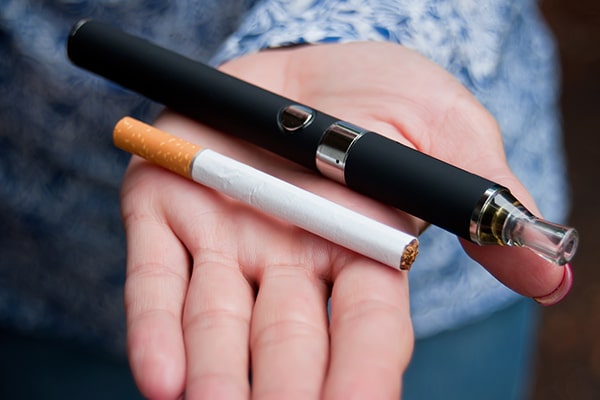
With lung cancer awareness month upon us, and many new insights into electronic cigarettes (e-cigarettes), it seems the perfect time to discuss these new and emerging products. Though they have been around for over a decade now, popularity continues to grow and new e-cigarette devices hit the market frequently.
Originally touted as a device to help smokers quit, e-cigarettes have changed into a highly effective nicotine delivery device which can at times rival the delivery seen with combustible cigarettes. Despite the improvements to nicotine delivery, research shows most users of combustible cigarettes who try the devices either stop using them altogether or become dual users of both e-cigarettes and combustible cigarettes.
A more controversial, but scientifically-backed trend, is the initiation of nicotine use through e-cigarettes by adolescents and young adults. Individuals who start using nicotine with e-cigarettes tend to go on to combustible forms of tobacco as well, which increases their risk for diseases including lung cancer. Thus, as a cessation tool, e-cigarettes overall have so far proved to be ineffective.
The latest questions surrounding e-cigarettes is whether they reduce current smokers’ risk of disease, or could be considered a “harm reduction” tool. This too currently has conflicting evidence.
With thousands of devices, even more types of liquid used in the devices and many ways to use e-cigarettes, research on what problems the products cause is complicated. Early evidence has varied from relatively benign findings with first generation e-cigarettes to levels of disease-causing chemicals similar to that of combustible cigarettes being found with the newer, more sophisticated products.
With no long-term data on overall health effects, many health organizations and public health policy suggests continued research is vital to truly understanding these new products. Despite no-long term data, there is still early evidence that the substitution of e-cigarettes for cigarettes may still carry health risks such as cardiovascular disease or respiratory illness, and dual use of e-cigarettes and cigarettes may not greatly reduce an individual’s exposure to chemicals known to cause disease. Thus, until more evidence is collected, best practice would be to stop using all tobacco and tobacco-derived products including e-cigarettes for optimal health.
When should I get screened for lung cancer?
Yearly low-dose CT scans are recommended if you:
- Are 55-74 years old and in fairly good health, and…
- Currently smoke or quit smoking in the past 15 years, and…
- Have at least a 30 pack-year smoking history.
*One pack per day for 30 years or two packs per day for 15 years would both be 30 pack-years.
Need help with a quit plan? Call 1-800-QUIT-NOW or visit www.quitnowkentucky.org.
The M. Krista Loyd Resource Center at UofL Brown Cancer Center also offers “Plan to be tobacco free” courses in conjunction with the Kentucky Cancer Program. Call 502-562-7092 to learn more.









